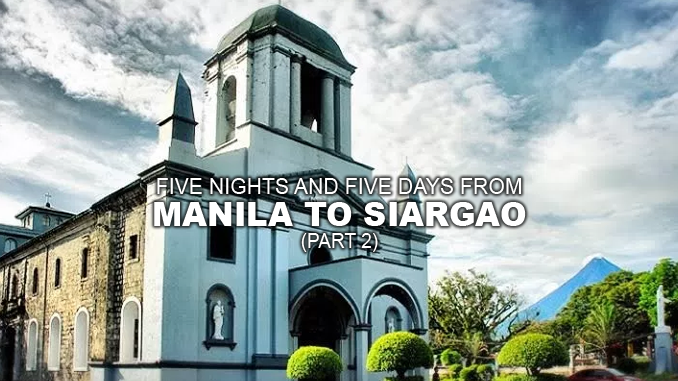Have you ever been on a road trip?
Everybody wants to go on a road trip. Well, not really everybody, but a whole lot, especially those who love life and its many adventures, like I do.
I have already done several, but this is my longest so far: 5 nights and 5 days from Manila to Siargao.
This, however, is only the short story of my road trip, churches edition. More details next time.
—
Night 1, no chance. I left Manila at around 9pm. I simply just prayed in my seat for a safe trip before rolling off. There was really no need to go to church and, at that time, most were probably already closed.
—
Day 1, there was a chance, but I did not take it. I was just dead tired and, by the time I recovered somehow, it was already time for dinner, drinks and conversations with the locals. I love conversations with the locals. It makes me feel like I am one of them, although I am of course not. But it makes me learn the hidden treasures of the place, and many other things not found in tourist pamphlets.
—
Night 2, I just slept.
—
Legazpi City, Daraga and Sorsogon City
Day 2, I woke up really excited. Maybe because of the wide assortment and selection at the buffet breakfast. Perhaps it was because the clouds have already parted and I can finally have a front row view of Mayon Volcano. In any case, this was the day I planned to visit churches along the way from Legazpi City to Matnog, Sorsogon, where I will ride the ferry to cross over to the Visayas.
First stop was St Gregory the Great Cathedral (Legazpi City). As it happened, this church was just at the foot of the hill where my hotel was located. I was there in just 5 minutes or probably more but it felt like 5 minutes.
St. Gregory the Great Cathedral is one of the oldest churches in the Philippines (the first wooden chapel was constructed in the 1580s). It is also known locally as the Cathedral of San Gregorio Magno and Albay Cathedral.
Second stop was Daraga Church (Daraga). Now this gave me more than just a front row view of Mayon Volcano. I felt like I was at the foot of the mountain itself and most probably I already was.
Daraga Church was built in 1772. It is also known locally as Nuestra Señora de la Porteria Parish Church and Our Lady of the Gate Parish Church.
Third stop was Sts Peter and Paul Cathedral (Sorsogon City). This was a quick one. I was running late to my ferry at Matnog, Sorsogon, and I still had to grab lunch. Yes, grab, for fine dining was out of the question. There was simply no more time for anything fancy.
Sts Peter and Paul Cathedral has undergone several makeovers through the years. The new church, which has a large dome that gives it a Vatican-like look, was inaugurated on April 27, 2011, on the occasion of the 60th year anniversary of the Diocese of Sorsogon. It is also known locally as the Sorsogon Cathedral.
—
Night 3, same as the night before. I just slept.
—
Calbayog City, Catbalogan City and Tacloban City
Day 3, I was scheduled to travel from Western Samar to Southern Leyte. This was not going to be a short one. In fact, this was going to be a very long one. But I had to visit some churches. You know, when the going gets tough, the tough get on their knees and pray. And so I did.
First stop was Sts Peter and Paul Cathedral (Calbayog City). This was a quick visit. I just whispered a prayer, took some photos, checked in on Facebook, then I sped off.


Sts Peter and Paul Cathedral was established in 1910. It is also known locally as the Calbayog Cathedral.
Second stop was San Bartolome Church (Catbalogan City). This was another quick one. Actually, a quicker one. I did the same routine, but faster. I had to reach Tacloban City for lunch.
San Bartolome Church was originally built in 1616. It was first burned in 1760 and again in 1835, but always rebuilt and repaired. It is also locally known as the Church of St Bartholomew.
Third stop was Sto Niño Church (Tacloban City). Now this was heartbreaking. The church still had its walls, but it already lost its roof. It also lost its door. There was construction ongoing, though. It will be whole, again, but maybe it will never be the same, again, but perhaps it will be better, this time, for it will be the testament of a people who kept the faith, despite all the death and destruction, and chose to rise, after falling and getting buried.
Sto Niño Church, in its present form, was built in 1986 and repainted in 2000. It was damaged by Supertyphoon Yolanda in 2013, and has since been repaired.
—
Night 4, and you already know what I did, I just slept. There is really no point in visiting a church at night (although I have done so before at a desperate time in my life, but I just stood outside the door, with my head bowed, with my eyes closed, with my voice low).
—
Malitbog and Sogod
Day 4, this was going to be my last day in the Visayas because I was already due to cross over to Mindanao, and I was not going to take any chances in not being able to visit at least one more church in this island. I was able to visit two.
This was also going to be the longest “sea” part of my “land” trip. Not knowing how to swim, as if I can swim in fearsome and freezing waves and at night at that even if I knew how to swim, this really gave me the jitters.
First stop was Sto Niño Church (Malitbog). I had time to pray a longer one. I felt really at peace with the fresh air, no smell of rotten lumber like in some; with the serenity of the silence, except the chirping of a bird or two; with the idea that I actually have time to stay longer at a church, and just sit after kneeling, without the need to stand up right away, and run the race of life without any rest.
Sto Niño Church was built in 1957. According to historical records, this church was built exactly in the middle of two warring barangays led by two warring capitanes. In fact, the town itself got its name from all these confusion brought about by this feud. Thus, the name Malitbog, which is a variation of the local word Makalibog, which means confusing.
Second stop was Immaculate Conception of the Blessed Virgin Mary Parish (Sogod). Now this brought me back in time, although I have not really been there, but I have watched enough old movies. This is not meant to offend anybody, but that wedding that was ongoing was really “back in time”. I arrived just when the members of the entourage started walking on the aisle towards the front. I watched until the bride reached the groom. And this should be as far as I go with what I saw.


Immaculate Conception of the Blessed Virgin Mary Parish Church was constructed in 1718 and was finished in 1720. It was razed to the ground in 1754 when it was attacked but has since undergone repairs and facelifts.
—
Night 5, as usual, as always, I just slept, but not without first saying a prayer, thankful for the past few days of safe trips, grateful that it will soon be over the next day because I will finally reach the destination of my road trip: Siargao.
—
Siargao
Day 5, I could not, anymore, even if I would have really wanted to. This was the day I scrambled for any seat at any boat just to go to Siargao, because all the available seats in all the scheduled boats have already been taken. Or so I thought.
To make the long story short, I was able to find a way to get to Siargao, and this meant I was able to find a way to visit my last church on my 5 nights and 5 days from Manila to Siargao.
First and last stop, Sto Tomas de Villanueva Church (Siargao). The church was already closed when I arrived, but it did not matter at all. I was not desperate this time, although I was a little earlier in the day, but I stayed at the church for a while, right outside the closed door. I was just thankful. I was just grateful.
Sto Tomas de Villanueva Church has its own festival called the Tikyabang Festival. It is held every 3rd week of September. It is to celebrate the bountiful harvest of “alimango” in the island.
And this ends my short, or not so short, story. All the other details of my road trip will be in a separate book.
Right after my 5 nights and 5 days in Siargao, my next accomplishment was being in the 3 islands (Mindanao, then Visays, then Luzon) of the Philippines in one and the same day. Yes, in one and the same day. This was my return trip from Siargao to Manila. But this is for the separate book or, as they always say, one for the books. Abangan!
















